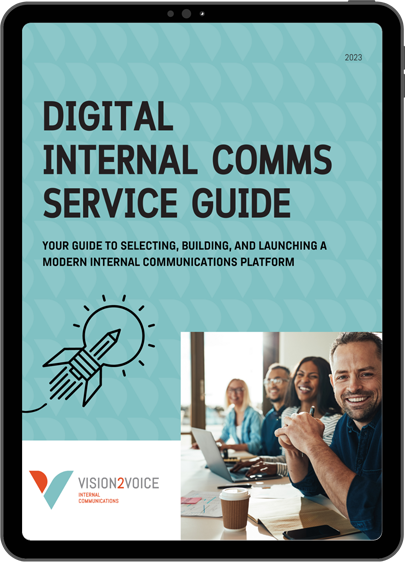
“As soon as you start talking, you crowd out all of the other ideas in the room.”
Vas Narasimhan, CEO of Novartis
As we usher in a new decade, leading thinkers are reimagining leadership, the role of technology in our lives, the responsibility business has to its stakeholders, and even social contract between business, government and society. With these people as inspiration, I am proposing a fundamental shift in the role of internal communications in organizations.
For years, companies have been focused on sharing news, curating and distributing content, and measuring results. There has been some great progress by many companies to elevate their internal communications function with a more strategic, creative and technology driven approach. There has also been some tremendous work by technology companies to create apps and solutions to modernize how we communicate with employees.
Unfortunately, in many organizations I have talked to or worked with, there remains a fundamental issue of finding a balance between keeping people informed while not overwhelming them with so much information that they don’t have time to focus on their jobs. Take the nurse on a busy hospital ward who works a 12-hour shift – should he focus on delivering babies or should he read your company email update? Exactly.
Many organizations also struggle with a lack of collaboration, difficulties changing course, and an absence of true innovation. So, what’s the answer?
I think the answer is to look at internal communication differently. I think leaders need to focus on listening to employees, giving them a strong voice, and actually involving them in decisions big and small. Moreover, I believe internal communications should be at the forefront of this revolution.
Let’s look at the definition of communication for a moment. A quick check on Dictionary.com says it is, “the imparting or exchanging of information or news.”
The key word for me is EXCHANGE.
The Unboss Concept
I’ve just started following Vas Narasimhan. He is the CEO of Novartis, one of the word’s largest pharmaceutical companies. He is amazing. He leads a gigantic business with almost 100,000 employees yet he has the courage to call himself a work in progress. (Aren’t we all!) He’s curious, he’s humble and human, and best of all he’s focused on learning and helping his people create new possibilities.
Under the leadership of Narasimhan, Novartis advocates the concept of being an unboss, which is essentially about giving all employees the power and the freedom to solve complex problems. Narasimhan focuses on listening and on coaching as a way of ‘accelerating human progress.’
The Magical Benefits of Involving Employees
The benefits of involving your employees in a meaningful way are many. Let’s take a quick look at some of them:
Unleash Potential
We spend a lot of time hiring great talent – people with skills, experience, and knowledge. Once they walk through the doors of your organization, you want to bring out the best in your valuable people and allow them to be able to contribute fully. There is no better way to do this than to involve them in key decisions and to make sure their ideas are heard.
Fuel Innovation
To compete and win in today’s complex and rapidly changing business environment, you need to innovate. Innovation doesn’t just have to come from your research and development (R&D) department – it should come from every corner of your organization. Ideas can come from every employee and a diversity of . When you empower every employee to help your organization solve problems, you will get a wider range of more creative ideas.
Better Decisions
Senior leaders often make decisions that will impact the work experience of the people below them. This can be risky because they are removed from the work and there may be blind spots or issues with their decisions that they just don’t see. When you involve people in decision-making, you can be sure that your decision creates a more workable solution.
Increase Buy-In and Support
Leaders can come up with the greatest strategy or the best ideas in the world, but if they don’t have buy-in and support, they will struggle to achieve results. When organizations increase involvement and give people a voice, it gives them a sense of ownership. This in turn creates greater commitment and buy-in and increases engagement. I’ve worked on many change projects where the changes are imposed on people and communicating and managing the change is a challenge. Involving employees very early on can significantly reduce change resistance and ensures employees stand behind the change from day one.
Create A Healthier Workplace
According to the Canadian Mental Health Commission, involving people in the workplace, making them feel valued and giving them a meaningful voice supports psychological health and safety.
How to Create a Culture that Involves Employees
This all sounds great, but how do leaders and their strategic internal communications advisors make this monumental shift? Here are my tips and some internal communication best practices. I’ve divided them into two groups: one that focuses on leadership and the other that focuses on internal communications.
Tips for Leaders
Start with Trust and Respect
Building a culture of trust and respect creates an ideal foundation for a more open and honest dialogue between people in organizations. It also helps leaders shift from focusing on reporting and micromanagement to giving more ownership to their employees.
Show Curiosity
Leaders should demonstrate curiosity by listening and asking questions. Researcher and leadership expert Adam Grant has challenged the myth that extroverted leaders are more successful because he found that introverted leaders are more likely to listen and be curious. As a leader, you can gain deep insight into the business and people if you take time to get to know various groups in your organization. To do this, ask how things are done and demonstrate an open mind instead of interrogating or interviewing staff.
Be Vulnerable
Brené Brown is a researcher and storyteller who studies shame, vulnerability and courage. She has many fans (myself included) but also some detractors who mistakenly believe that leaders who show vulnerability will be seen as weak. Well guess what, everyone has strengths and weaknesses and it takes courage to admit what those are. Great leaders understand their weaknesses and are open to improving, learning and growing. It’s really that simple.
Take a Close Look at Governance, Systems and Culture
I’ve witnessed organizations where the way decisions are made, how people are rewarded and even the culture are not optimized for an open exchange of ideas and diversity of thought. It’s also not uncommon to see groupthink[1] in organizations where it is frowned on if someone questions the status quo or is critical of the company. Sometimes, there is a structured process that drives decision-making that is based on a hierarchy, leaving little room for input or involvement of employees.
Tips for Internal Communications
If your internal communications includes feedback channels for listening, that is a great start. What you should be striving for is a continuous exchange of information and ideas rather than a few token listening channels or activities. Here are some ideas for pushing the boundaries even farther.
Respond
Whether it is a suggestion box or a survey delivered by a fancy app, make sure you let people know what you’ve heard. It’s critical that you demonstrate that feedback and ideas are valued and taken into consideration. Don’t be afraid to highlight specific cases or stories where an employee made a difference by voicing a concern or sharing an idea. This will provide positive affirmation of the type of behaviour you want to encourage.
Validate
Make sure that what you’ve heard is well-founded. I once worked on a project where the data told us that over 95% of employees understood the reason for change. When we probed deeper, we realized that the level of understanding for the reasons behind the change were very superficial and there was more work to be done to explain the business need driving the change.
Disrupt Your Channels
When researching this blog, I came across the idea of a talent showcase where leaders would invite lower level talent into higher meetings. You could do this with town hall meetings where you have employees run the show instead of the CEO. Another excellent idea that I heard from TEDx coach, Teri Kingston is to organize an internal TED-style Talks event where employees can share their “ideas worth spreading.” I am sure a quick brainstorming session would reveal many other ways you can flip the conversation so you can give people a chance to contribute to their fullest potential and increase their sense of ownership.
Time for a fundamental shift
Ever since industrialization, the workplace has been characterized by hierarchies and a chain of command. Our organizations place a strong emphasis on accountability, and short-term increases in productivity and profit sometimes at the expense of long-term thinking .
2020 marks the beginning of the fourth industrial revolution where the talents, ideas and knowledge of people will be harnessed to drive innovation and solve our most pressing business and global challenges. Isn’t it time our leaders and organizations rethink internal communication to make sure this can happen?
[1] Groupthink is a psychological phenomenon that occurs within a group of people in which the desire for harmony or conformity in the group results in an irrational or dysfunctional decision-making outcome.

A Winning Formula for Internal Communications
Read The Free eBook
Our eBook shares our unique formula for building business culture and driving success. Find out the 3 key factors in attracting, inspiring and retaining high-calibre talent. Get your free copy when you subscribe to our newsletter. Be the first to know about new blog posts and stay up to date with industry news.
Download the ebook




